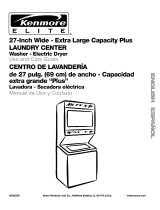
Do not store or operate your washer in temperatures at or below
32°F (0°C). Some water can remain in the washer and can cause
damage in low temperatures. See "Washer Care" in the
Washer User Instructions for winterizing information.
Recessed area or closet installation
The dimensions shown are for the recommended spacing
allowed, except the closet door ventilation openings. The
dimensions shown for the closet door ventilation openings are
the minimum required.
i
m
n
olo
m
(O=rn) (IBSJBCm} (Ocm) (2,,Ycm) (64,Ball) (t0.2m)
1 2
__ J_ 3,,
II"1 ...
1. Front view
2. Side view
3. Closet door with vents
• Additional spacing should be considered for ease of
installation and servicing.
• Additional clearances may be required for wall, door and floor
moldings.
• Additional spacing of 1 in. (2.5 cm) on all sides of the washer
is recommended to reduce noise transfer.
• If a closet door is installed, the minimum air openings in the
top and bottom of the door are required. Louvered doors with
air openings in the top and bottom are acceptable.
• Companion appliance spacing should also be considered.
The washer can be installed using the standpipe drain system
(floor or wall), the laundry tub drain system, or the floor drain
system. Select the drain hose installation method you need. See
"Alternate Parts."
3g-
(N©m)
L
1 2
Standpipe drain system - wall or floor (view I & 2)
The standpipe drain requires a minimum diameter standpipe of
2 in. (5 cm). The minimum carry-away capacity can be no less
than 17 gal. (64 L) per minute. A 2 in. (5 cm) diameter to 1 in.
(2.5 cm) diameter standpipe adapter kit is available. See
"Alternate Parts."
The top of the standpipe must be at least 39 in. (99 cm) high and
no higher than 96 in. (244 cm) from the bottom of the washer.
Laundry tub drain system (view 1)
The laundry tub needs a minimum 20 gal. (76 L) capacity. The top
of the laundry tub must be at least 39 in. (99 cm) above the floor
and no higher than 96 in. (244 cm) from the bottom of the washer.
Floor drain system (view 2)
The floor drain system requires a siphon break that may be
purchased separately. See "Alternate Parts."
The siphon break must be a minimum of 28 in. (71 cm) from the
bottom of the washer. Additional hoses might be needed.
Electrical Shock Hazard
Plug into a grounded 3 prong outlet.
Do not remove ground prong.
Do not use an adapter.
Do not use an extension cord.
Failure to follow these instructions can result in death,
fire, or electrical shock.
A 120-volt, 60-Hz., AC-only, 15- or 20-ampere, fused
electrical supply is required. Time-delay fuse or circuit
breaker is recommended. It is recommended that a separate
circuit serving only this appliance be provided.
This washer is equipped with a power supply cord having a 3
prong ground plug.
To minimize possible shock hazard, the cord must be
plugged into a mating, 3 prong, ground-type outlet, grounded
in accordance with local codes and ordinances. If a mating
outlet is not available, it is the personal responsibility and
obligation of the customer to have the properly grounded
outlet installed by a qualified electrician.
3











